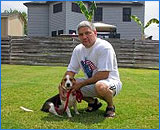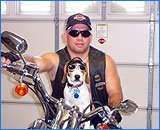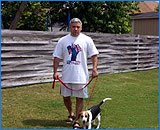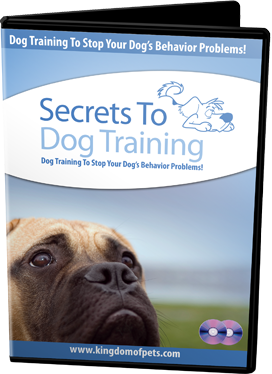If you are looking for the greatest gold-mine of easy to use "change your dog's behavior" advice ever crammed into a newsletter series then read on!
Also, make sure that you check out our 100% authentic testimonials from people who have bought Secrets to Dog Training and find out the massive difference it has made to their owner-dog relationship!
 "My dog Harley is a beagle, he is 5 months old, very active, aggressive and curious. Harley and I have been working the lessons from your book for at least three months now. We are very pleased about the results. I must say you cover everything that puppy gets into. The funny thing is when I see him behaving in a wrong manner I run to your book, look it up then apply the technique that pertains to the behavior, consistently and everyday until the results are automatic.
"My dog Harley is a beagle, he is 5 months old, very active, aggressive and curious. Harley and I have been working the lessons from your book for at least three months now. We are very pleased about the results. I must say you cover everything that puppy gets into. The funny thing is when I see him behaving in a wrong manner I run to your book, look it up then apply the technique that pertains to the behavior, consistently and everyday until the results are automatic.
 Harley (My beagle) is doing well now as a result of your wonderful step by step instructional book he is for the most part house trained, no longer digs, he sits, stays, heels and I understand his behavior much better.
Harley (My beagle) is doing well now as a result of your wonderful step by step instructional book he is for the most part house trained, no longer digs, he sits, stays, heels and I understand his behavior much better.
Harley and my families relationship is getting much stronger because we are all consistent with the same commands and your book guides us to understanding Harleys habits and reasons.

Thank you Mr. Stevens for making the book simple, easy to understand and internet available."
-- Rocky And Family Toves (USA)
Hi Daniel,
I have a problem with my new pup. He is 51/2 months old and i cannot use a leash on him. When I put on the leash he grabs it in his mouth and won’t let go. I am afraid that I might break off some teeth if I jerk on the leash. Please let me know how to rectify if you have had this before.
Thanks
Jon.
Hi Jon,
Thanks for you email regarding your new five and a half month old pup. It is relatively common to have problems getting your puppy used to a leash and collar, and it should be a relatively easy problem to fix with time. It is well known that dogs who walk well on leash face fewer dangers and have more fun. It's well worth the time to develop this skill with your puppy despite the trouble you are currently experiencing.
Obviously your puppy is used to the collar you have given it, which is a fantastic start! The next step should really be to ensure and re-enforce the come, sit and stay commands to that you can call him to you and make him sit quietly while you attach the leash. Please see the relevant sections in Secrets to Dog Training for more information here.
The next step is to add a leash. Some pups seem overwhelmed by an entire leash all at once. In these cases you can start with a string, shoelace, or something of the sort. Add length as the puppy gets used to it. Attach the leash or the short item to the collar when the puppy is eating or playing, and let the pup get used to it being there. Don't remove it when pup is making a fuss about it. Remove it at a time the pup has forgotten it's there. Do not leave a leash on an unattended dog. It can catch on things and trap the dog in dangerous and traumatic situations. Leashes are only safe during supervised times.
For your particular puppy it will be important to distract it into play or other interaction with you whenever the he starts to chew it. It's fine to apply Bitter Apple, vinegar or chili to the leash, but please realize these substances do not last long as a chewing deterrent, and will need to be reapplied for every session. Doing this can keep leash-chewing from ever becoming a habit, and save you money, work and the worry of a loose dog. I would recommend not trying to jerk the leash out of your puppy’s mouth, as yes this can damage and/or accidentally yank out the puppy’s teeth. Instead reprimand the dog with a guttural growl saying "Aaaah!". If necessary, physically open the puppy’s jaws until the leash falls out – do so carefully such that neither you nor the puppy is harmed however.
Next the puppy needs to get used to the leash itself without you holding the other end. Treats are ideal for this training. The puppy won’t always need treats to walk on a leash. Leash walking has its own rewards, but your young puppy doesn't know this yet. The treats will help get things moving in the right direction. Feeding time is a good time to work on this conditioning, when you have the dish in your hand and an eager puppy at your feet. Back away from the puppy. Use your body language and the puppy's name to attract the puppy to follow. Move around a bit with your puppy, making it a fun game, before putting down the dish and thus delivering a great reward.
At other times when your puppy is likely to be interested in games and treats, use a bit of food from the puppy's next meal to condition the puppy to look at you and move with you Keep moving away from the puppy, encouraging the puppy to follow you. Young puppies naturally do this anyway, so the training is easy and fun. At all times, be prepared to reward your puppy with little treats, games and other things the puppy likes, for moving with you, coming to you, and looking at you. Make this a habit, and develop your body language and voice to what works best with THIS puppy. Each puppy is different. Pups have different things they like best, and different things they respond to in different ways. You can build your puppy's desires to interact with you by how you use your praise, treats, petting, and the games you and your puppy play together. All of this factors into your leash training as well as all other training, both in puppy hood and later on in your dog’s life.
The next step is of course to pick up the other end of the lead and attempt training from here as per normal.
I hope this has been of some help to you and your puppy. Please let us know how you get on with the training. Hopefully you undertake the training in such a way that is fun enough for your puppy not to want to chew that leash!
Best of luck and thank you for the email.
Kind regards,
Daniel Stevens and the Secrets to Dog Training Team
"Secrets to Dog Training - STOP Dog Behavior Problems!"
 I've been a professional dog trainer for well over 20 years, and in that time I've helped thousands of dog owners just like you to get the friendly, well behaved, slipper fetching, best pal they always wanted.
I've been a professional dog trainer for well over 20 years, and in that time I've helped thousands of dog owners just like you to get the friendly, well behaved, slipper fetching, best pal they always wanted.
But it didn't start out that way. I've always loved dogs, some things never change. But when I first started my professional dog training career I relied on the so-called 'best practices' when it came to dog behavior training. It was only when I heard people tell me over and over again that they just weren't seeing results that I started to question the old accepted wisdom. So I started a journey, a quest to search out the best, most effective, techniques, tips, and tricks that really work.
And that's how I came up with Secrets to Dog Training. Year after year I found new techniques that achieved the results I wanted. Eventually I had a whole book worth of great resources: Secrets to Dog training...
So, if you want to:
Then Secrets to Dog Training is just what you've been looking for!
Previous newsletters
| 01 | 02 | 03 | 04 | 05 | 06 | 07 | 08 | 09 | 10 | 11 | 12 | 13 | 14 | 15 | 16 | 17 | 18 | 19 | 20 | 21 | 22 | 23 | 24 | 25 |